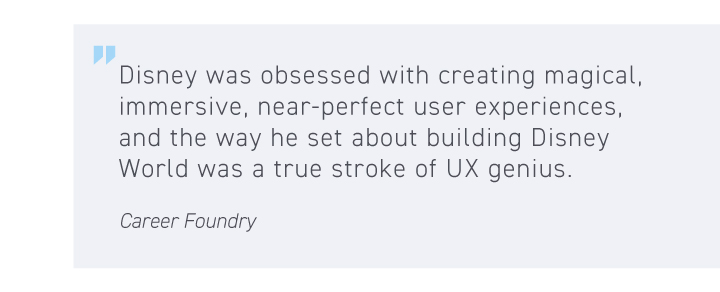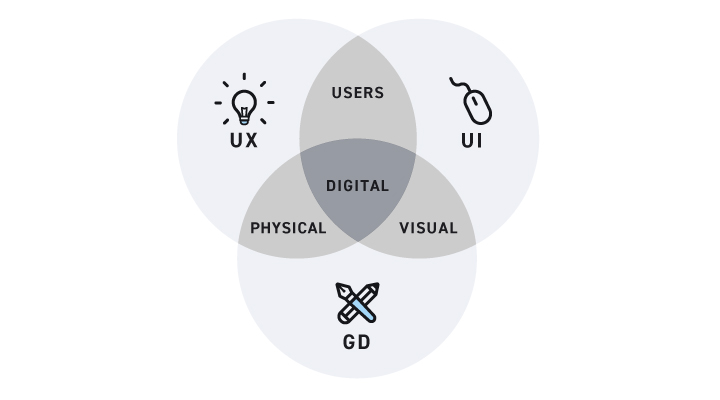Visual design, of one type or another, appears on just about everything you buy, read, or consume. From your milk carton to your go-to mobile app, design is everywhere you look. But who is creating all these designs that draw us in?
You might assume it’s the work of the Graphic Designer. While this field is the most widely understood, the market’s recent concentration on User Experience (UX) and User Interface (UI) means you probably interact with the work of UX and UI Designers more frequently than you realize. So, how do those roles compare to each other?
A History of Graphic Design
Most people probably recognize the title Graphic Designer. It’s the original — and, some would argue, the best — career path for anyone interested in creative commercial design. But where did this type of work come from?
Canva says the field took off with the Industrial Revolution, when improved printing presses were used to mass-produce eye-catching designs in order to grab consumers’ attention.
Over the years, more specific roles have evolved from this one job description. There are now Graphic Designers that specialize by medium (web, print) or by type of product (apparel, consumer packaged goods).
The crucial point is: graphic designers don’t create art for art’s sake. They create commercial designs that sell a product or service.
With the rise of the internet and mobile apps, two new disciplines, UX and UI, are in high demand. These roles are focused on the end user, or the experience of the person encountering the visual design.
CareerFoundry says the first UX Designer was probably Walt Disney. His goal, in movies, cartoons, and in theme parks, was to create an immersive user experience — which is the basic goal of UX and UI Designers today.

No matter the field, Graphic and UX/UI Designers are first and foremost storytellers. In the same way that a musician puts together lyrics and sound to create a vibe, these creative professionals use imagery, text, motion, and color to create feeling or to encourage the consumer to behave in a certain way.
What exactly does a UX Designer do all day? How does that role differ from a UI Designer? Let’s compare graphic design, UI, and UX to understand these unique but interrelated creative professions.
Graphic Design
Graphic design is the science of making things look visually appealing. While Graphic Designers make aesthetic choices for the visual landscape, they are not artists. They choose the right layouts, graphics, fonts, and colors to make a visual function for the brand’s purpose. Graphic Designers can work in many visual media, from print to the digital screen, product packaging, to an in-store display.
Graphic design is so much more than making things look good. It's about ensuring the project makes sense. A Graphic Designer’s tools are hierarchy and organization — of both visual elements and content — with the goal of driving consumers to a certain action, whether that's to read the brochure from beginning to end, to request more information, or to make a purchase.
User Interface (UI)
Two key differences between graphic design and user interface design are that UI is always digital and always interactive. UI Designers work at the end-user level with interactive elements such as:
- Animations
- Button styling
- Clickable elements
- Drop-down menus
- Form fields
- Icons
- Layouts
UI Designers focus on the visual design where the product interfaces (or interacts) with the consumer, creating prototypes and wireframes for digital tools. They analyze what users will experience when they interact with a digital product.
When you use an app, a UI Designer is the one who decided that pushing a specific button would create a specific action. UI Designers typically create an end user flow that takes you through the process of interacting with a website or app. This flow is crucial to the design of any digital user experience, and it’s the bread and butter of the UI Designer. But that’s only one piece that goes into a software build.
User Experience (UX)
While UX and UI intertwine and overlap, they also have distinct differences. UX is most concerned with the user’s journey within your app, site, or other digital interface. A UX Designer researches and validates the UI elements created on a website or mobile app. UI makes sure the interfaces functionally work.
The UX Designer has a number of tools to help them understand the user experience:
- Competitor analysis
- Heuristic analysis and journey mapping
- Pain point analysis
- Persona creation
- User interviews
- Wireframing
Some of these techniques are performed at the front end of the design process and some at the back. For example, usability or pain point analysis can happen after the product has launched. Wireframing usually happens at the beginning of the digital product design.
A UX Designer concerns themselves with an analysis of human intent as users interact with a digital product, specifically, what does the end user feel, think, or experience when they interact with a digital product that has a certain design element in play. UX is about design but it is also about the function behind the design. (Read on to get a better idea of A Day in The Life of A UX Designer)
UX, UI, or Graphic Design?

Think of UX as the skeletal infrastructure behind the design. Where should that button take you and why? Do we need a form at this point in the customer journey? UI creates the interface details such as colors, typeface, or sounds. Together, UX and UI create the entire end user experience on a digital product.
Graphic Designers also create with the customer in mind, but their graphics could be on a cereal box, a billboard, a website, or just about anywhere else.
UX, UI, and Graphic Design all are irretrievably intertwined. All are concerned with the end user’s ability to function with the design. In all three roles, the ultimate goal is to create an emotional bond with the end user to improve their interaction and experience with a product that the visual design is aiming to sell.
Still trying to figure out which role you need to hire or which job would be best for you? Talk to Artisan Talent. We have design jobs for creative professionals and networks of talent for employers. Our team can help you reach your goals.




